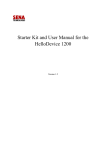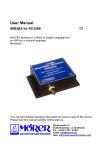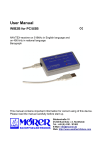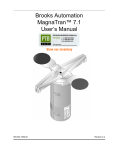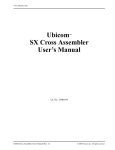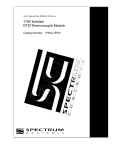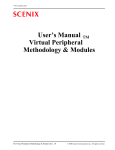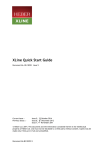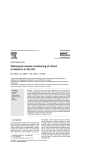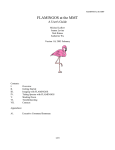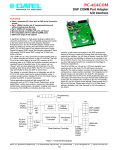Download Starter Kit and User Manual for the HelloDevice
Transcript
Starter Kit and User Manual for the HelloDevice 1100 Version 1.1 Starter Kit and User Manual for the HelloDevice 1100 Version 1.0 Last revised on July 16, 2000-07-16 Printed in Korea Copyright Copyright 2000, Sena Technologies, Inc. All rights reserved. Sena Technologies reserves the right to make changes and improvements to its product without providing notice. Trademark HelloDevice™ is a trademark of Sena Technologies, Inc. Windows® is a registered trademark of Microsoft Corporation. Ethernet® is a registered trademark of XEROX Corporation. Notice to Users When a system failure may cause serious consequences, protecting life and property against such consequences with a backup system or safety device is essential. The user agrees that protection against consequences resulting from system failure is the user's responsibility. This device is not approved for life-support or medical systems. Changes or modifications to this device not explicitly approved by Sena Technologies will void the user's authority to operate this device. Company Address Sena Technologies, Inc. 210 Yangjae-dong, Seocho-gu Seoul, Korea 137-130 Telephone: +82-2-573-7772 Fax: +82-2-573-7710 Email: [email protected] Website: http://www.sena.com Table of Contents 1. Before You Start 2. Overview 3. Main Board Specifications 3.1. Power Supply 3.2. Microprocessor 3.3. Ethernet Interface 3.4. Digital I/O Interface 3.5. Flash Memory 3.6. Firmware 4. Setting Up the Hardware 4.1. Installing Utility Software 4.2. Connecting Hardware 4.3. Configuring Network 5. Quick Tour 5.1. Building a Homepage 5.2. I/O Control Demo Using Demo Board 6. Connecting User Devices 6.1. Communication Protocol 6.2. Implementing Hardware 6.3. Sample Programs Appendix A. IP address configuration by using cross-over Ethernet cable Starter Kit and User Manual for the HelloDevice 1100 1. Before You Start. § Items supplied in the HelloDevice 1100 Starter Kit Items Hardware Software Piece(s) HelloDevice 1100 Main Board 1 5V Switching Mode Power Supply (SMPS) or Power Adaptor 1 Demo Board for I/O Control 1 Cable for I/O Control (20 pins, 2.5mm pitch) 2 HelloDevice Utility Software and Sample Demo Program (Download the latest version at http://www.sena.com) User Manual § § 1 1 Operating Environment − Voltage Supply = 5V DC ±10% − Current Supply = 200mA or lower − Operating Humidity = 0 ~ 95% − Operating Temperature = 0 ~ 50 Degrees Centigrade Technical Support Sena Technologies, Inc. 210 Yangjae-dong, Seocho-gu, Seoul, Korea 137-130 Phone: (+82-2) 573-7772 Fax: (+82-2) 573-7710 Email: [email protected] http://www.sena.com 1 Starter Kit and User Manual for the HelloDevice 1100 2. Overview The HelloDevice is a connectivity solution that allows any device in any industry to communicate over any network, using any interface. The HelloDevice 1x00 product family is a board-level Ethernet controller that lets manufacturers and system integrators connect devices such as home appliances and industrial control systems directly to the Internet via Ethernet, and remotely communicate with and control them with standard web browsers such as Microsoft Explore and Netscape Navigator. The HelloDevice 1x00 product family is categorized into three types depending on how the HelloDevice connects to a user device: § Digital I/O communication module (HelloDevice 1100) § Dual-port RAM communication module (HelloDevice 1200) § Serial communication module (HelloDevice 1300) Table 2.1 shows the basic specifications of the HelloDevice 1x00 Series. Model Basic Spec. HelloDevice 1100 HelloDevice 1200 HelloDevice 1300 Scenix Sx52BD (8 bits microprocessor, 50 MIPS) 512 Kb flash memory (Saves user Web files) CPU Memory Network Connection 10 Base-T Ethernet Interface (IEEE802.3) Connection to the User device Internet Protocol Support Utility Software 16 contact points digital 1 channel input 2 KB dual port RAM RS-232/485 16 contact points digital Max. 38,400 bps output HTTP1 / SMTP / BOOTP TCP / UDP IP / ICMP / ARP Ethernet (IEEE802.3) HelloDevice utility software (for Windows 95/98/NT/2000 platform) : IP addressing and Web page uploading Table 2.1 Basic specifications of the HelloDevice 1x00 1 Currently, HTTP 1.1 specifications are supported. 2 Starter Kit and User Manual for the HelloDevice 1100 3. Main Board Specifications The hardware configuration and the system block diagram of the HelloDevice 1100 Main Board are shown below in Figure 3.1 and Figure 3.2. (The board layout in Figure 3.1 may be slightly different from the layout of the HelloDevice main board in the Starter Kit for the performance improvement.) 4 16 points digital Input (5V TTL) 5 3-1 16 points digital output (5V TTL) 10 Base-T Ethernet Controller 512 Kb Flash Memory J1 J2 3-3 Status Display LED Pow er Collision Rx Tx 53 mm 86 mm 3-2 RJ45 Ethernet Connector 1 2 Microprocessor Pow er Supply ( 5V DC ) Figure 3.1. HelloDevice 1100 Configuration and Components RJ45 connector to Ethernet 10 Base-T filter Ethernet controller (10 Base-T) Sx52BD microprocessor 512 KB Flash Memory Power supply 16 point TTL input 16 point TTL output Figure 3.2. HelloDevice 1100 System Block Diagram 3 Starter Kit and User Manual for the HelloDevice 1100 3.1 Power Supply § § Voltage supply = 5V DC ±10% Current supply = 200mA or lower 3.2 Microprocessor Specifications § Scenix SX52BD 8 Bit Microprocessor § 4 KByte Program Memory § 52-pin PQFP (See Figure 3.1, Part [2]) 3.3 Ethernet Interface The HelloDevice is connected to an Ethernet hub or switch by the RJ45 connector on the Main Board. Distances of up to 100m are supported. 3.3.1 Ethernet Controller The Ethernet Controller provides the functions of framing and addressing data, and detecting and avoiding errors and collisions (See Figure 3.1, Part [3-1]). 3.3.2 Specifications § RealTek Full-duplex Ethernet Controller: RTL8019AS § Supports 10 base-5, 10 base-2 and 10 base-T compliant with IEEE802.3 § 16 KByte SRAM § NE2000 Compatible 3.3.3 RJ45 Connector § Shielded Connector compliant with AT&T258 specifications (See Figure 3.1, Part [3-2]) 4 Starter Kit and User Manual for the HelloDevice 1100 1=Tx+ 8=NC 2=Tx- 7=NC 3=Rx+ 4=NC 6=Rx - Pin No. Description Red Line 1 Tx+ White with orange 2 Tx- Orange 3 Rx+ White with green 4 Not used Blue 5 Not used White with blue 6 Rx- Green 7 Not used White with brown 8 Not used Brown 5=NC Figure 3.3. RJ45 connector 3.3.4 Status Indicator LED's There are four status indicator LED’s which indicate the following: (See Figure 3.1, Part [3-3]). § Power LED Indicates the Power-On status of the HelloDevice. § Rx LED Indicates that the Ethernet controller is receiving Ethernet packets from the network. If it is correctly connected to the network, this LED will blink when packets are received § Tx LED Indicates that the Ethernet controller is sending packets. Before setting the HelloDevice network configuration, this LED will blink every second. After network configuration, if connected correctly, this LED blinks only in response to requests from the user's PC, for example ping or server activity. § Collision LED Indicates that one or more Ethernet packets transmitted from the Ethernet controller to the network may have collided with another packets. In this case, the Ethernet controller will automatically resend the packets. 5 Starter Kit and User Manual for the HelloDevice 1100 3.4 Digital I/O Interface The digital I/O interface of the HelloDevice 1100 is equipped with 16 input / 16 output contact points. Users can connect switch or On/Off sensors to the input contact points, or connect LED or On/Off actuators to the output contact points. The following table shows the voltage specifications for I/O control. The power supply for the operation comes from the HelloDevice connectors. Control Signal Voltage Level Input Hi voltage (ViH) Input Min. Normal Max. (V) (V) (V) 2 5 Input Low voltage (ViL) 0 Output Hi voltage (VoH) Output 2.5 0.8 5 Output Low voltage (VoL) Table 3.1. Voltage specifications for HelloDevice I/O operation Digital I/O between the user device and the HelloDevice is performed through 2.5mm pitch, 20-pin connector J1 and J2. The Figure 3.4 shows pin assignment of the I/O connectors. 5V TTL Output Contact Point (16) 5V TTL Input Contact Point (16) Vcc GND 2 4 6 8 10 12 14 16 18 1 3 5 7 9 11 13 15 17 Vcc 20 19 GND Vcc GND 2 4 6 8 10 12 14 16 18 1 3 5 7 9 11 13 15 17 Vcc 20 19 GND Figure 3.4 Pin assignment of I/O control connector 6 Starter Kit and User Manual for the HelloDevice 1100 3.5 Flash Memory Web page resources files that the user creates to control the user device are stored in the flash memory of HelloDevice Main Board. § 4 MBits (512 KBytes) § Composed of 2,048 sectors of 256 Bytes. 3.6 Firmware The HelloDevice Firmware resides in the program memory of microprocessor. The firmware includes a TCP/IP stack conforming to the Open System Interconnection (OSI) requirements for an Internet connection, and the digital I/O interface for connection to the user devices. Layer The HelloDevice Supports: HTTP Digital I/O Control 7 Application 6 Presentation 5 Session 4 Transport 3 Network TCP 2 Data link IP / ICMP 1 Physical layer Ethernet (IEEE802.3) System Setting BOOTP UDP ARP Table 3.2. OSI 7 Layers and the HelloDevice 1100 Firmware 7 Starter Kit and User Manual for the HelloDevice 1100 4. Setting Up the Hardware The HelloDevice 1100 is as follows: § Install the HelloDevice Utility Software on user's PC § Connect the HelloDevice to the power supply and Ethernet § Set the IP address of HelloDevice § Check the HelloDevice network connection. 4.1 Installing Utility Software Run setup1x00.exe in the HelloDevice CD-ROM from the PC that is connect to the network. Setup1x00.exe runs on Microsoft Windows 95/98, NT and 2000. Select [Complete] and press [Next] button in the setup type display screen. Figure 4.1. Initial screen of the HelloDevice utility software installation program 8 Starter Kit and User Manual for the HelloDevice 1100 The setup program will automatically be installed onto c:\Program Files\HelloDevice utility folder. Figure 4.2. Screen that shows the HelloDevice utility software is being installed Once setup is completed, a shortcut icon of the HelloDevice Utility Software is created on the desktop and on the program menu. If the following HelloDevice utility main window appears when the shortcut is clicked, the setup has been successfully completed. Figure 4.3. Initial screen for the HelloDevice utility software 9 Starter Kit and User Manual for the HelloDevice 1100 4.2 Connecting Hardware (1) Connect the 5V DC power supply adaptor to the HelloDevice and press the Reset button. 110/220 V 5V Power HelloDevice Figure 4.4. 5V power connection to the HelloDevice (2) Connect the HelloDevice to the Ethernet hub through the RJ45 connector. (Refer to the Chapter 3 Main Board Specifications for more details on the RJ45 connector.) 5V Power Ethernet backbone 110/220 V HelloDevice Ethernet Cable Hub & Switch Figure 4.5. Connection of the HelloDevice and Ethernet cable (3) Check to see if the Tx LED of the HelloDevice Status Display LED blinks periodically (one-second interval). (See the [Status LED] in the Figure 3.1) 10 Starter Kit and User Manual for the HelloDevice 1100 4.3 Configuring Network In order for a HelloDevice to function as a server on the network, a static IP address must be set for the HelloDevice. This section describes how to configure and change IP address for a HelloDevice. 4.3.1 Setting IP Address The HelloDevice Utility Software is used to set up an IP address for a HelloDevice by utilizing BOOTP (BOOTstrap Protocol), which is defined in the Internet protocol standard, RFC-951 and RFC-1542. The Utility Software provides BOOTP a server function, and will respond to the BOOTP request of the HelloDevice. Since the factory default setting of the HelloDevice IP address is 0.0.0.0, the HelloDevice sends BOOTP request for IP assignment, when it is powered up for the first time. Thus, users can see Tx LED keeps blinking periodically as a reminder (See Figure 3.1, Status LED). Since IP address of the HelloDevice is managed by an IP address database, a properly allocated MAC2 -IP address record should be entered into the database. For a valid IP address, users should ask their network administrator. Take the following steps to set up the IP address, using the HelloDevice Utility Software. BOOTP database record management function BOOTP database list BOOTP server function IP address tracing/modifying function Figure 4.6 IP address setting screen of the HelloDevice utility software 2 MAC(Media Access Control) address is total 6 bytes and it is composed of 3 bytes-organization code and 3 bytes-product code. MAC address of HelloDevice is composed of 00-01-95 which is a company code and xx-xxxx which is a product code. E.g. 00-01-95-01-aa-08 11 Starter Kit and User Manual for the HelloDevice 1100 Setting an IP address with the HelloDevice Utility Software: (1) Run the HelloDevice Utility shortcut icon on the desktop of your PC and select [IP Set-up] menu click on the [IP Set-up] window. This window provides the BOOTP server function for IP address setup (([BootP Start], [BootP Stop]), trace function ([IP Find]) and IP address initialize functions ([IP Clear]). (2) Press the [Add] button and enter the BOOTP database record as shown below. Figure 4.7 BOOTP Database Record Input Window Enter MAC address, IP address of HelloDevice. 1 and 6 should be always fixed for H/W address type and H/W address length items for Ethernet. MAC address is printed on the sticker on the Ethernet controller chip of HelloDevice main board. Figure 4.7 shows an example setting of 00:01:95:04:02:03 MAC address and 192.168.1.15 IP address. Since the BOOTP function of HelloDevice is working by using broadcast message, you don’t have to enter gateway address and sub net mask. (3) Click [Add] button to finish database editing. The records entered in step (2) are added to the IP database. (4) Launch the functions of BOOTP by pressing the [BootP start] button. The HelloDevice Utility will then operate as a BOOTP server. Note that the message on the [Status] bar will change from “Monitoring” to “Listening BOOTP request”. If HelloDevice Utility gets BOOTP request from a certain HelloDevice which does not exist in BOOTP DB List, it will run "DB Setting for BOOTP" window automatically. User should enter IP address and Gateway address of the HelloDevice, and add them to BOOTP DB list. 12 Starter Kit and User Manual for the HelloDevice 1100 (5) Check the status of Tx LED on HelloDevice. The HelloDevice Utility Software will send a reply for IP assignment to the BOOTP request of the HelloDevice. The Tx LED will be blinking periodically to indicate a BOOTP request. At this point, [Status] bar displays the “BootP reply sent... [ 192.168. 1. 15 ]” message. Wait until Tx LED does not blink any longer, and then stop the functions of BOOTP server by clicking [BOOTP Stop] button. (6) Use the ping command to check your IP address setting of HelloDevice. Run the ping program at the command prompt. If your IP address is correctly set, the response to the ping will be as follows: >> ping 192.168.1.15 >> Pinging 192.168.1.15 with 32 bytes of data: Reply from 192.168.1.15: bytes=32 time=10ms TTL=251 Reply from 192.168.1.15: bytes=32 time<10ms TTL=251 Reply from 192.168.1.15: bytes=32 time=10ms TTL=251 If the response above is not displayed, the IP address was not entered correctly, so you should repeat steps (4), (5) and (6). (7) Use [IP Find] to identify IP address setting of HelloDevice. Click [IP Find] button, and the window in figure 4.8 will be shown. Enter the MAC address of HelloDevice and click [Find] button. The IP address currently set in the “Found IP” item will be displayed. Figure 4.8 IP address check using the [IP Find] function (8) Check if the HelloDevice web server operates correctly. The HelloDevice has a built-in 404.html file in flash memory (factory default). To check the functions of your web server, run any web browser and connect to the address http://192.168.1.15. The web page in Figure 4.9 13 Starter Kit and User Manual for the HelloDevice 1100 verifies that the HelloDevice works successfully as a web server. Figure 4.9 HelloDevice default Web page 4.3.2 Changing IP address To change the IP address, initialize the IP address to the factory default value of 0.0.0.0, and repeat the procedures of setting an IP address in section 4.3.1. At this point, ask your network administrator for a new IP address. For example, let's try to change IP address of 192.168.1.15 to 192.168.1.18. (1) Initializing IP address Before you initialize IP address of HelloDevice, you have to remove IP/MAC address data stored in your PC. This information is stored in ARP cache, and you can make sure what is stored in the cache by using the following command. This is the response of the command in case that IP address of user PC is 192.168.1.100. >>arp -a Interface: 192.168.1.100 on Interface 2 Internet Address Physical Address Type 192.168.1.15 00-01-95-04-02-03 dynamic 192.168.1.23 01-a0-11-34-11-0d dynamic 14 Starter Kit and User Manual for the HelloDevice 1100 Remove the corresponding item to the current HelloDevice information by using the following command. >> arp –d 192.168.1.15 Now, you are ready to initialize current IP address of HelloDevice. Go to [IP Setup] window and click [IP Clear] button to display a window where you can clear the IP address. If you want to clear the current IP address of 192.168.1.15, just enter the current setting of the IP address as shown below in figure 4.10 and click [OK] button. Then, the present IP address of 192.168.1.15 set on HelloDevice will be changed to factory default of 0.0.0.0. Figure 4.10 IP address Clear window (2) Verifying the initialization of an IP address Check if Tx LED of HelloDevice blinks. When an IP address is initialized, the HelloDevice will send the BOOTP request message. The Tx LED of the HelloDevice will keep blinking. (3) Resetting an IP address To reset an IP address to 192.168.1.18, edit/modify the contents of the IP address database using the [Edit] function and repeat the procedures of setting an IP address in section 4.3.1. Figure 4.11 IP address change using the [Edit] function in the IP address database 15 Starter Kit and User Manual for the HelloDevice 1100 5. Quick Tour This chapter describes how to build a homepage on the HelloDevice web server and demonstrates I/O control between the HelloDevice Main Board and Demo Board. The following sample program files are included in the Starter Kit. 1) First Web server demo sample 2) Demo sample of I/O control through the Web 3) Java applet source code for I/O demo 4) C program source code for I/O demo In chapter 5.1, we will start the Web server using the sample 1), and control the I/O device of the demo board through the Web using the sample 2). Sample 3) and 4) will be covered in Chapter 6 Implementing I/O Control Function for the User Device. Sample (1) Sample (2) Sample (3) Sample (4) Figure 5.1 Locations of HelloDevice Sample Files 5.1 Building a Homepage For the HelloDevice to function as a web server, web resources like HTML files, image files, and Java class files should be stored on the flash memory of the HelloDevice up to 256 files or a total data size of 500 KByte can be 16 Starter Kit and User Manual for the HelloDevice 1100 stored on the flash memory. Since the HelloDevice does not use a general operating ststems, web files are managed in the form of “file index table”. Web files are stored in the flash memory of the HelloDevice by building an integrated image file and then uploading it onto the HelloDevice. This image file contains a file index table that is recognized only by HelloDevice web server. The HelloDevice Utility Software provides the functions of building and uploading this type of file. To make HelloDevice function as a web server, perform the following steps: (1) Create the web pages with a web-publishing tool. (2) Use the HelloDevice Utility Software to transform the created web pages into an uploadable form. (3) Upload the transformed files to the HelloDevice. (4) Use a web browser to connect to the uploaded web page. In this example, use the web files in the “FirstDemo” folder to construct a web server home page. These examples are composed of: an index.html, HelloDevice block diagram and cube animation demo with a Java applet. (1) Select [Web files] tab to go to the window containing web file manager tools. Find and Build Web File List box clear Select Build File Upload Built File Figure 5.2. Web File Tool screen of the HelloDevice Utility Software (2) Click [Find] button to find web files to build. Go to the folder containing the example files, select the top-level “FirstDemo” folder, and click [OK] button. 17 Starter Kit and User Manual for the HelloDevice 1100 Figure 5.3. Finding Web server demo files (3) Select a file name to build. Figure 5.4. Saving Web sample Build file Enter the file name of the built image and click [Save] button to save. By default the HelloDevice web files built, will have the extension “hd”. The current window closes and “Build complete” dialog box appears. (4) Enter an IP address of the HelloDevice to upload the built files. 18 Starter Kit and User Manual for the HelloDevice 1100 Figure 5.5. Entering the IP address to upload the built files (5) Click the [Target file] button to select the built image files to upload. Figure 5.6. Screen of selecting the Build files to upload (6) Click [Upload] button to upload the built image files to HelloDevice. This procedure is displayed on the Progress bar, and when it has finished, a “Flash download completed!!” dialog box will appear. 19 Starter Kit and User Manual for the HelloDevice 1100 (7) Enter URL http://192.168.1.15/index.html in the web browser, and try connecting. The web page in Figure 5.7 will appear. If not, you might not have entered the value of the IP address correctly and as a result the web server will not operate successfully. If the web page fails to appear, check the IP address setting of web server and reload the file. Figure 5.7. HelloDevice, “FirstDemo” Web page screen A user's homepage can be customized in the same way as described above. 5.2 I/O Control Demo Using Demo Board 20 Starter Kit and User Manual for the HelloDevice 1100 The HelloDevice 1100 Starter Kit provides a Demo Board and sample programs for demonstrating digital I/O. This section will demonstrate the HelloDevice I/O functions. 5.2.1 Connecting the Demo Board (1) Turn off the HelloDevice power and remove the Ethernet cable. (2) Insert the HelloDevice to the demo board through the digital I/O connector. HelloDevice Digital I/O Demo Board Figure 5.8. How to insert the HelloDevice into the demo board (3) Connect the power to the HelloDevice again, and connect the Ethernet cable. Ethernet Cable 5V Power Ethernet backbone Hello Device Digital I/O Demo Board Figure 5.9. Hardware installation for HelloDevice digital I/O demonstraton 21 Starter Kit and User Manual for the HelloDevice 1100 5.2.2 Web Demonstration Use the sample Web files located in the “IODemo” folder in HelloDevice utility software for digital I/O control on the Web. (Refer to the file location in the Figure 5.1) Web files used for the digital I/O demo are “index.html”, “io.jar” and “404.html”. This example demonstrates control of the demo board I/O with the HelloDevice connected to the Web (1) Modify the IP address in the “index.html” file in the “IODemo” folder. Input the current HelloDevice IP address to the IP address parameter related to the Java applet in the “index.html” file. Leave other parameter unchanged and save the file. <HTML> <HEAD> <TITLE>IOdemo</TITLE> </HEAD> <BODY> <H1>IOdemo</H1> <APPLET CODE=IOdemo.class ARCHIVE=io.jar WIDTH=250 HEIGHT=300> <param name=host value="192.168.1.15"> <param name=port value=6001> <param name=polling value=1> </APPLET> </BODY> </HTML> Figure 5.10. Modifying the “index.html” file for digital I/O control Note! Several parameters can be used for Java applet I/O communication. - IP address: HelloDevice IP address - TCP port: Always set as 6001 - Polling interval: 100 ms resolution, Set proper value according to the application e.g. “polling value =1” means that I/O status will be polled at every 10 ms. (2) Build and upload the Web files in the “IODemo” folder. Upload the Web page to the HelloDevice by following the steps described in the Chapter 5.1. Select the “IODemo” folder that contains the Web files, instead of the “FirstDemo” folder. 22 Starter Kit and User Manual for the HelloDevice 1100 (3) When uploading is completed, run the Web browser and connect to the http://192.168.1.15/index.html. The following I/O demo Web page will appear. This screen matches the switches and LED's on the demo board. Switch and LED mapping is described in Figure 5.12. Figure 5.11. Web page screen of digital I/O demonstration (4) Checking digital output control: Buttons on the left side of Web page are used to issue the digital output commands (the number show the output contact points). When the user presses the “0” on the Web page, the LED 0 on the demo board will be toggled on and toggled off when pressed again. (5) Checking digital input detection: The LED’s on the right side of the Web page are used to display digital input, and match the switches on the demo board. Check to see if the LED color is changed from red to green by pressing the switch on the demo board. 23 Starter Kit and User Manual for the HelloDevice 1100 Figure 5.12. Relationship between the digital I/O demo screen and Demo Board 24 Starter Kit and User Manual for the HelloDevice 1100 6. Connecting User Devices The I/O control commands are transferred to the HelloDevice through the TCP/IP protocol using the Internet socket interface program installed in the user PC. The HelloDevice controls the output contact points of its I/O interface as “high” or “low”, and checks the values of the input contact points(“high” or “low”). Input values are transmitted through the network to the socket interface program on the user PC. This provides remote command and monitoring functions through the Internet. Figure 6.1 shows the remote control/monitoring configuration of the HelloDevice and the command/response path. In short, for the user to implement a hardware control and monitoring function through the Internet using the HelloDevice, he has to carry out two tasks: (1) Implement the Internet socket program or Java applet as specified by the HelloDevice communication protocol. (2) Configure hardware to match the HelloDevice I/O interface. 192.168.1.15 : TCP 6001 Port 16 Contact Points Output Actuator Switch 16 Contact Points Input Sensor HelloDevice Comm. Protocol Responds to I/O Contact Point Status Commands to Control I/O Contact Point Ethernet 192.168.1.23 User PC 192.168.1.21 User PC Figure 6.1. Remote control/monitoring of the HelloDevice 25 Starter Kit and User Manual for the HelloDevice 1100 Chapter 6.1 will describe the HelloDevice communication protocol; Chapter 6.2 will describe the I/O demo board and how to implement user hardware that complies with the HelloDevice I/O interface. 6.1 Communication Protocol In order to perform remote I/O control on the Internet, the Internet socket interface should be implemented on the user PC for Internet communication with the HelloDevice. The socket interface can be implemented with: § C language-based socket program, § Or, Java applet running on the Web. The Internet socket interface for communication with the HelloDevice should be implemented according to the TCP/IP protocol. This sends the I/O control command to the current IP address and to the TCP port number 6001. The HelloDevice interprets the commands to control the I/O device connected to the actual HelloDevice. The Table 6.1 summarizes the communication commands and response that are sent between the socket interface and the HelloDevice. Operation Type Direction Communication Packet User PC HelloDevice è ç è I/O Get Command I/O Get Command Response Output Set Command Monitoring I/O Status Output Control Table 6.1. List of communication commands/responses for HelloDevice I/O control 6.1.1 I/O Status Monitoring I/O status is monitored by a command and its response Commands are sent from the socket interface of the user PC to the HelloDevice in order to read the HelloDevice I/O status. The Figure 6.2 shows the table used to interpret the monitoring command and its response, and output I/O contact point. Number of Byte 1 2 0x75 Input Contact Status Type Command to monitor the I/O status Response to I/O status monitoring 15 14 13 12 11 10 9 8 Input Contact Point MSB 7 6 5 4 3 2 1 Input Contact Point LSB Input Contact Point Status 0 15 14 13 3 4 Point Output Contact Point Status 12 11 10 9 8 Output Contact Point MSB 7 6 5 4 3 2 1 0 Output Contact Point LSB Output Contact Point Status Figure 6.2. HelloDevice I/O communication protocol 26 Starter Kit and User Manual for the HelloDevice 1100 The status value of I/O monitor command and response depends on user’s design of the hardware. For example, the status value may be set as LOW to turn on LED if LED circuitry is designed to operate as Active LOW. The user should be careful when setting or interpreting the status value, since the result will be based on the hardware design. Currently, the Input switches of Demo Board are designed to work as LOW-Active mode, whereas output LED’s are implemented as HIGH-Active mode. The examples in this chapter will be based on the assumption that you are using HelloDevice Demo Board. For example, when the input contact point 0, 2, 4 and 10 are in the high state and the output contact point 1, 3 and 5 are in the high state, the HelloDevice will send the FB:EA:00:2A hexadecimal value response as shown by the Figure 6.3. The socket interface program will interpret this value and display each input and output contact point according to the value (Only the input contact point 0, 2, 4 and 10 as well as the output contact point 1, 3 and 5 are in the high state.) 15 14 13 12 11 10 9 8 7 6 5 4 3 2 1 0 15 14 13 12 11 10 9 8 7 6 5 4 3 2 1 0 1 1 1 1 1 0 1 1 1 1 1 0 1 0 1 0 0 0 0 0 0 0 0 0 0 0 1 0 1 0 1 0 1111 | 1011 | 1110 | 1010 = 0xFBEA 0000 | 0000 | 0010 | 1010 = 0x002A Input Contact Point Status Output Contact Point Status Figure 6.3. Interpretation of the I/O status Note: In response to the I/O status monitoring command, 4 bytes data in total is practically required that combines 16 input points and 16 output points (32 points = 32 bits = 4 bytes), but the HelloDevice always sends 16 bytes value to the user PC. Therefore, the user should interpret the first 4 bytes of the receiving packet. That’s because the Ethernet packet of the general PC LAN card is set to receive at least 64 bytes, including IP, TCP headers, and the LAN card discards the packet that is shorter than minimum Ethernet packet length so that the packet sent from the HelloDevice to the user PC cannot reach to the socket interface of the user PC. The packet that the socket interface receives will be as follows: 2 bytes 2 bytes 60 bytes Input contact point status Output contact point status NULL data 6.1.2 Output Control Command The output control command is used to set the output contact points of the HelloDevice to high or low discretionary, and no response is generated. 27 Starter Kit and User Manual for the HelloDevice 1100 Number of Byte Type Output status control command 1 2 3 0x76 Output Contact Point Status For example, if the user wants to set the HelloDevice output contact point 0, 1, 2 and 3 as high and others as low, the value should be 0x000F and send the hexadecimal value 76:00:0F to the HelloDevice as shown by the Figure 6.4. Output Control Output Contact Point MSB Command Output Contact Point MSB 8~0 15 14 13 12 11 10 9 8 7 6 5 4 3 2 1 0 - 0 0 0 0 0 0 0 0 0 0 0 0 1 1 1 1 0x76 0x00 0x0F 15 14 13 12 11 10 9 8 7 6 5 4 3 2 1 0 0 0 0 0 0 0 0 0 0 0 0 0 1 1 1 1 0000 | 0000 | 0010 | 1111 = 0x000F Output Contact Point Status Figure 6.4. Example of output control command 6.2 Implementing Hardware In this chapter, the I/O demo board is configured as an interface between the HelloDevice and user I/O device. 6.2.1 HelloDevice I/O Demo Board The HelloDevice I/O demo board is composed of 16 switches for input demo, 16 input display LED's and 16 output display LED's. The switches for input demo were designed to run at the “Low Active”, and the output display LED's were designed to run at the “High Active”. Switch for input demo HelloDevice point CLOSED OPEN LOW HIGH input contact Input display LED ON OFF HelloDevice output contact point Input display LED LOW HIGH OFF ON 28 Starter Kit and User Manual for the HelloDevice 1100 The power for the demo board is supplied from the HelloDevice through Vcc/GND pin of 20-pin I/O interface connector. Figure 3.4 shows the pin assignment of the HelloDevice I/O interface unit and I/O demo board. Figure 6.6 shows the circuit diagram of the HelloDevice I/O control board. Users can design their own I/O hardware in consideration of this diagram. Use two 20-pin connectors (J1 for the HelloDevice input unit and J2 for the HelloDevice output unit) to connect the HelloDevice to the I/O demo board. Additionally, the user can connect the demo board to his I/O device by connecting J3 to the input unit and J4 to the output unit (the HelloDevice J1 is by-pass connected to the J3 of the demo board and HelloDevice J2 is by-pass connected to the J4 of the demo board.) When J3 and J4 on the demo board are connected in this way, the I/O demo board included in this Starter Kit can be used to debug user’s I/O device. 29 Starter Kit and User Manual for the HelloDevice 1100 Figure 6.6. Circuit diagram of the HelloDevice I/O control board 30 Starter Kit and User Manual for the HelloDevice 1100 6.2.2 Implementing your Hardware 1) Connection to the HelloDevice The user can directly connect his device to the HelloDevice using the 20-pin connector (2.5mm pitch) instead of connecting through the demo board. The users can access the 5V power supply from the HelloDevice through 20-pin connector, or provide their own power supply. The state of the input or output contact points can be initialized to run as the High Active or Low Active. The I/O contact points of the HelloDevice run at 5V TTL power, and can recognize high or low inputs depending on the hardware design, or can set the output status as high or low depending on user design. 2) Input Unit Design The user device can send high or low signal of 5V TTL level to the input interface unit of the HelloDevice through the photocoupler. That is, when the photocoupler (PC345) connected to the input terminal of the external device becomes an “ON” status, the input contact point unit of the HelloDevice can receive the signal and drops from high to low. Hello Device Vcc R4 R I_A 4 1 IN PC? 3 2 PC354NT I_B i. Figure 6.7. Example of input interface hardware design with the HelloDevice 3) Output Unit Design The 5V TTL level signal generated by the HelloDevice is set to match the voltage level of the user device. When the status of the output point is changed from high to low by connecting the photocoupler (PC817) of the HelloDevice between Vcc and the output point, a relay can be used for on/off control of the connected device Figure 6.8 shows an example of a circuit to use an output contact point. 31 Starter Kit and User Manual for the HelloDevice 1100 OB Hello Device Vcc P24 K1 4 3 1 6 R3 10K 2 DSP1a-DC24V D1 1N4148 LED? LED RED 1 2 1 1 OA 4 3 2 Q3 2 OUT ISO19 PC817 3 1 KTD1028 R2 330 G24 Figure 6.8. Example of output interface hardware design with the HelloDevice 6.3 Sample Programs 6.3.1 Communication Using the Socket Program The following C program source code shows an example implementing the Internet socket interface using the Berkeley socket C API. This sends and receives the I/O control signals through the TCP port number 6001 of the HelloDevice. The users can program an application for remote I/O control by modifying this sample code to suite his application. The full source can be obtained in the “…\Source\C\iodemo.c” subdirectory of the HelloDevice installation folder. //--------------------// Process I/O Monitor //--------------------void IOMonitor() { char commandBuf, *ResponseBuf ; int commandLen, lenReceived ; int i ; // Initialize TCP socket TCPSocketInit() ; // Make TCP command commandBuf = IOGet ; commandLen = 1 ; // Send command to HelloDevice err = sendto ( sock, &commandBuf, commandLen, 0, 32 Starter Kit and User Manual for the HelloDevice 1100 (struct sockaddr*)&clientAddr, sizeof(clientAddr) ) ; if (err == -1) { perror("\nsend error\n"); exit (1); } // Allocate buffer for incoming packet = 16 bytes ResponseBuf = calloc(0x10, sizeof(char)) ; // Receive incomming packet.... lenReceived = recvfrom ( sock, ResponseBuf, 0x10, 0, (struct sockaddr*)&clientAddr, &clientLen ); if (lenReceived < 0) { perror("\nError receiving???\n") ; exit(0) ; } // Display incoming packet size printf("\n%d bytes received...\n", lenReceived) ; // Store I/O status for future use for (i=0; i<4; i++) IOStatus[i] = ResponseBuf[i] ; // Display I/O status printf("\n\n*********************************\n") ; printf("Input : %x:%x\t\tOutput : %x:%x", IOStatus[0], IOStatus[1], IOStatus[2], IOStatus[3]) ; printf("*********************************\n") ; // Free free(ResponseBuf) ; // Close TCP socket TCPSocketClose() ; } //--------------------// Process Output set //--------------------void OutputSet() { char commandBuf[3] ; int commandLen ; int outbit=0, outdata=0x0001 ; // Read output set value printf("Select the output point to be set (0-15) :") ; scanf("%d", &outbit) ; outdata <<= outbit ; // Read current output status IOMonitor() ; // Re-Initialize TCP socket TCPSocketInit() ; // Determine the output value considering current output status outdata |= ((IOStatus[2]<<8) | IOStatus[3]) ; // Make TCP command 33 Starter Kit and User Manual for the HelloDevice 1100 commandBuf[0] = IOSet ; commandBuf[1] = (BYTE) ((IOStatus[2] >> 8) & 0x000000ff) ; commandBuf[2] = (BYTE) (IOStatus[3] & 0x000000ff) ; commandLen = 3 ; // Send command to HelloDevice err = sendto ( sock, &commandBuf, commandLen, 0, (struct sockaddr*)&clientAddr, sizeof(clientAddr) ) ; if (err == -1 ) { perror("\nsend error\n"); exit (1); } } 6.3.2 Communication Using Java Applet The program source code for a Java applet (IOdemo.java, IOComm.java, Led.java and OutButton.java) can be found at the “…\Source\java” subdirectory of the HelloDevice installation folder. The users can build his own Web-based remote I/O control by inserting this Java applet in to their Web page. The following Java program source shows an example implementing the Internet socket interface using a Java applet that sends and receives I/O control signals through the TCP port number 6001 of the HelloDevice. /* Output read */ public int readValueTCP() { Socket socketTCP = null; int tmp = 0; int inputData = 0; byte rxData[] = new byte[16]; byte data[] = {COMMAND_GET}; try { socketTCP = new Socket(InetAddress.getByName(m_host), m_port); socketTCP.setTcpNoDelay(true); socketTCP.getOutputStream().write(data, 0, data.length); instream = new DataInputStream(socketTCP.getInputStream()); tmp = instream.read(rxData, 0, rxData.length); if (tmp != -1) { inputData = (int) (rxData[2] << 8 | (rxData[3] & 0x00ff)); inputData &= 0xffff; } socketTCP.close(); instream.close(); } catch (Exception e) { System.out.println("Err : " + e); } return inputData; } /* Output write */ public void wirteValueTCP(int outdata) { Socket socketTCP = null; byte[] data = new byte[4]; 34 Starter Kit and User Manual for the HelloDevice 1100 data[0] = COMMAND_SET; data[1] = (byte) ((outdata >> 8) & 0x000000ff); data[2] = (byte) (outdata & 0x000000ff); // Initialize socket try { socketTCP = new Socket(InetAddress.getByName(m_host), m_port); socketTCP.setTcpNoDelay(trujhe); socketTCP.getOutputStream().write(data, 0, data.length); socketTCP.close(); } catch (Exception e) { System.out.println("Err: " + e); } } 35 Starter Kit and User Manual for the HelloDevice 1100 Appendix A. IP address configuration by using cross-over Ethernet cable You may configure the wrong IP address for the HelloDevice that cannot be run in your current network environment. You might not initialize the IP address of the HelloDevice before you install it to different network environment. In these cases, you cannot access the HelloDevice via network, since only network-based IP configuration function is provided in the HelloDevice. In these cases, you will have to use cross-over Ethernet cable for communication with the HelloDevice. The ordinary Ethernet cable is straight type, in which Rx line is connected into Rx line of other side and Tx line with Tx line of other side. Meanwhile, crossover Ethernet cable is a cable with Rx connected to Tx of the other side, and Tx to Rx of the other side. Straight Ethernet cable Cross-over Ethernet cable Rx+ Rx+ Rx+ Tx- Rx- Rx- Rx- Tx+ Tx+ Tx+ Tx+ Rx- Tx- Tx- Tx- Rx+ You can emulate the 1:1 networking if you hook up cross-over cable between your PC and the HelloDevice, without being affected by network routing. Take following steps for IP address reconfiguration. 1) Remove Ethernet cable from your PC 2) Directly hook up cross-over cable between your PC and the HelloDevice HelloDevice 5V power suply RJ45 User PC Cross over Ethernet Cable 36 Starter Kit and User Manual for the HelloDevice 1100 3) Configure the network environment set-up of your PC so that it can communicate with the HelloDevice. TCP/IP parameters of network configuration should be modified temporarily. e.g. Let’s say that IP address of the HelloDevice is 192.168.1.23 and that of your PC is 172.168.1.22. Modify the IP address of your PC and gateway as shown in the following picture. You may modify the IP address to different IP address of 192.168.1.xx other than 192.168.1.23, since those addresses can also be working in the subnet. Then, press [OK] button. You will have to keep in mind your original network environment set-up parameters, since this is temporary set-up for IP address reconfiguration of the HelloDevice. 4) Make sure if your PC can communicate with the HelloDevice by using ping utility >> ping 192.168.1.23 >> Pinging 192.168.1.23 with 32 bytes of data: Reply from 192.168.1.23: bytes=32 time=10ms TTL=251 Reply from 192.168.1.23: bytes=32 time<10ms TTL=251 Reply from 192.168.1.23: bytes=32 time=10ms TTL=251 5) Run the HelloDevice Utility program 6) Take steps described in chapter 4.3.2, “Changing IP address” 37








































